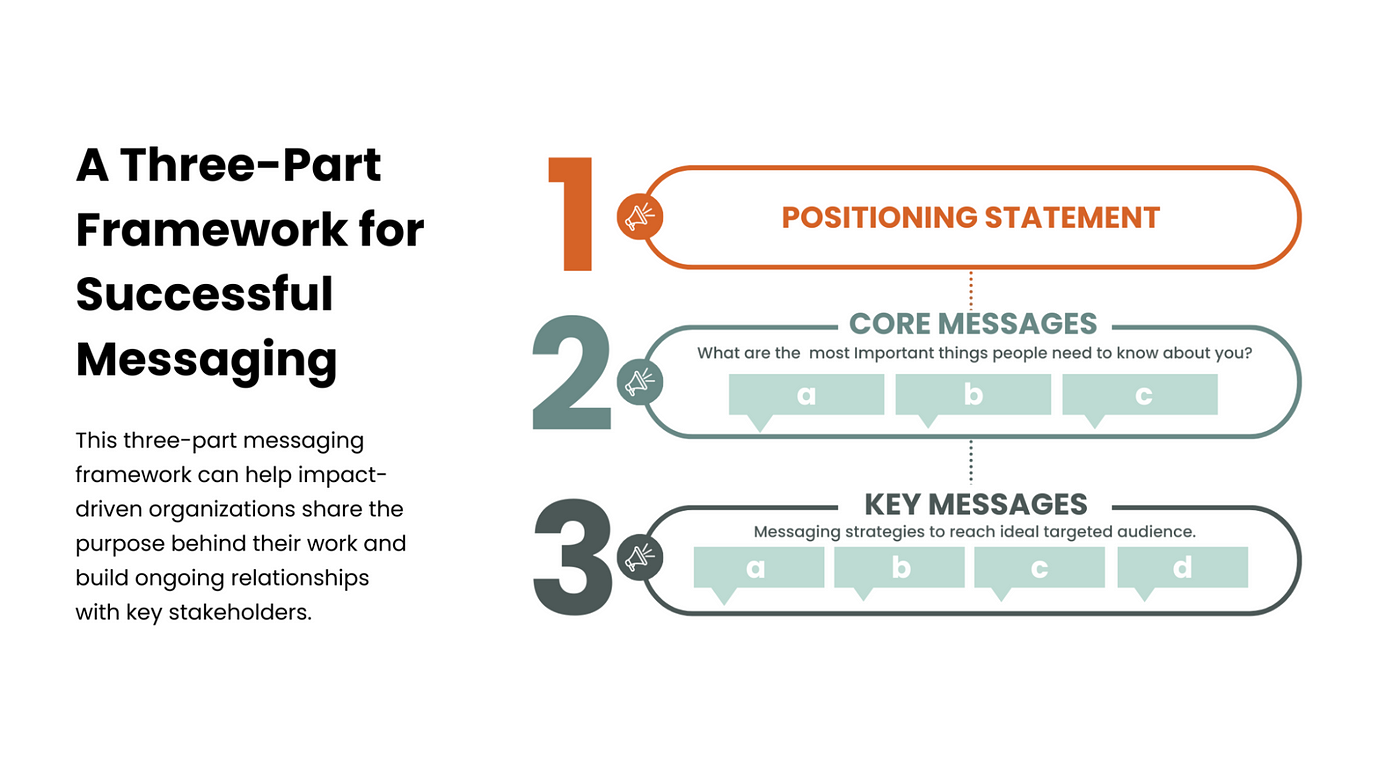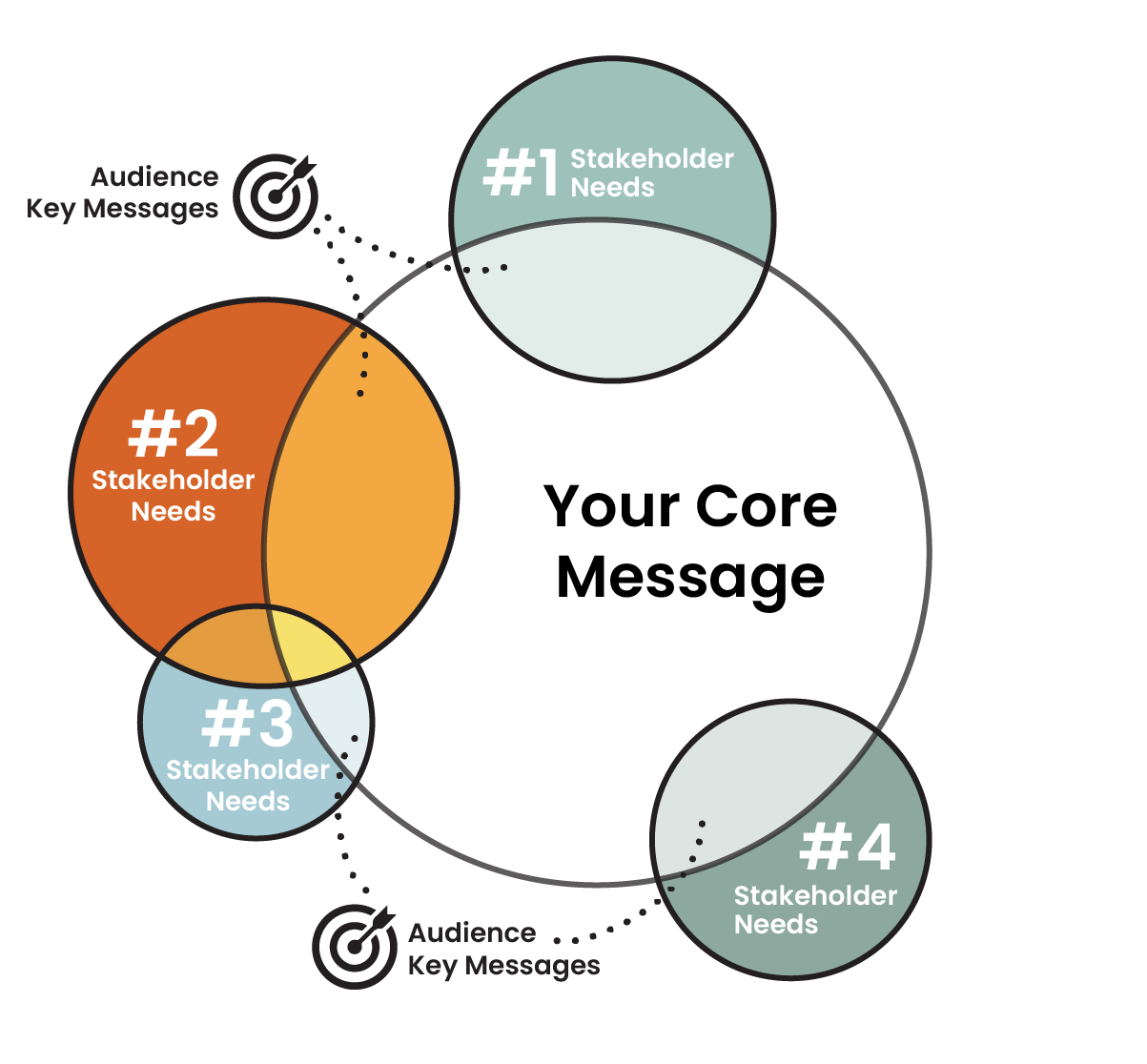ave you ever been sharing a story with a colleague only to see their eyes glaze over? It’s easy to assume they’re just not interested or paying attention, but the issue may not be with the message itself — it might be in how you’re delivering it. Are you connecting the story to something that’s relevant to their work or something they’re passionate about? If we don’t frame our communications through the lens of “why you should care” for the other person, it becomes much harder to capture and keep someone’s attention.
This concept of aligning your message with the right audience’s interests is crucial not just in personal interactions but in crafting an effective messaging strategy for your organization.
Let’s quickly recap the core messaging strategies we have covered so far in our series on developing an effective communications framework. In the first article, we explored why an effective positioning statement is an important foundation for your communications framework. To illustrate this process, we created a fictional company, Ethical Honey Co., and developed an example positioning statement. The second article outlined how a positioning statement can help shape organizational core messages. These brief, memorable statements communicate what your organization wants to achieve, why it matters, and, most critically, why your stakeholders should care.
The final step in our series on developing an effective communications framework will be about how to connect stories with the right stakeholders. These are the folks most interested and ready to take action with your organization. With these stakeholders in mind, we use the core messages to construct key messages tailored to each of your organization’s stakeholder audiences. Keep reading for some sweet examples featuring our fictional client, Ethical Honey Co.

Stakeholders and Key Messages
Now that we’ve established your core messages, it’s time to tailor them into key messages that directly speak to each of your stakeholder audiences. While core messages are broad and more focused on the company, brand, or nonprofit as a whole, key messages are the result of interpreting core messages to speak specifically to the needs of each audience segment.
Identifying your organization’s stakeholders — a more focused subset of your general audience — is essential to this process. Your target stakeholder audiences may include customers, supporters, workers, communities, the environment, shareholders or funders, among others. However, what truly matters isn’t just the categories they fall into but the shared motivations that align them with your organization and make them receptive to your message.
Let’s revisit our example of Ethical Honey Co. to illustrate how to identify your target stakeholder groups. While the company might be tempted to communicate its message to “anyone who likes honey,” the real focus should be on those who align with the company’s vision and want to support ethical beekeeping practices.
That means that Ethical Honey Co.’s stakeholders aren’t just “potential customers” or “honey buyers” — they are people who care about animal welfare and healthy ecosystems. People who believe in providing quality jobs in low-resource areas might also be included, or investors looking to support climate-positive food businesses. Ethical Honey Co. can create meaningful connections by showing these specific stakeholder audiences how their company and products meet their needs.
This Seems Like a Good Time for a Venn Diagram
The overlap between your organization’s values and your stakeholders’ needs is the target of your key message and the value you bring to the communities you serve. This concept is critical and often overlooked. A lot of organizations opt for a broad message that says, “This is what we’re doing,” assuming it will resonate with everyone. But adapting that broad message into a targeted message like “You need X; we can help you because Y” is much more effective and human. Crafting targeted messages — or key messages — requires considering how your core messages overlap with your stakeholder audiences’ needs and objectives.

Back to the honey company. While the company’s core goals — selling honey, supporting bees, and supporting employees — remain consistent no matter the stakeholder, the reason why each stakeholder should care and the action we hope they will take will vary.
Here’s a look at Ethical Honey Co.’s stakeholder audience segments and why they might care to support Ethical Honey Co.
- People who support ethical beekeeping: Ethical Honey Co.’s hive management replicates bees’ natural behavior and supports bee health.
- People who care about healthy ecosystems: Responsible beekeeping promotes healthy natural environments and the health of all pollinators.
- People who believe in providing quality jobs in low-resource areas: Ethical Honey Co.’s employees enjoy a cooperative structure and livable wages.
- Investors who are looking to discover new businesses to support: Partnering with Ethical Honey Co. offerse a values-aligned way to access an emergent new investment potential.
Here’s a Try at Key Messages for the Stakeholder Audiences
As with our Core Messages, our series of Key Messages is designed to guide stakeholders from first awareness to ultimate action. Let’s tailor our first Core Message, which focuses on building awareness, to resonate with each of our key stakeholders. Here is Core Message 1: You can purchase the highest-quality, most delicious honey while protecting and supporting the health and well-being of the bees and other pollinators that are so critical to the health of our planet.
And here are key messages for each stakeholder:
Ethical beekeeping supporters: If you care about the well-being of bees and other pollinators, make sure you choose our honey that upholds the highest standards for hive management and ecosystem health.
Healthy ecosystem supporters: Our product goes way beyond honey — healthy honeybees are a critical foundation for pollinator health, biodiversity, ecosystem well-being, and a thriving planet.
Quality job supporters: Our company provides well-paying jobs and helps build critical skills in an underserved area — you can help us one sweet jar at a time.
Investors: Our innovative business model offers triple-bottom-line impacts and is poised for growth.
And Finally: What Are Proof Points?
Finally, a critical aspect of your messaging framework is ensuring that your core and key messages are supported by proof points and examples. Proving your messages requires showing, not just telling. That means going beyond mere declarations to sharing stories — with illustrative examples and anecdotes — that show stakeholder audiences how your company meets their needs and adds value.
Let’s visit our example one more time. How do we “prove” to supporters of ethical beekeeping that Ethical Honey Co.’s hive management replicates the natural behavior of bees and supports bee health? We could simply state it, but it would be far more compelling to interview a beekeeper who compares Ethical Honey Co.’s practices with industrial-scale honey companies. We could build upon that message with a series of infographics highlighting specific differences between the two methods. And we could broaden the message by getting quotes from a scientist who studies bee and ecosystem health, or from the Ethical Honey Co. CEO, who was motivated to start the company by her passion in this area. An article that incorporates all of these elements serves as a relevant proof point for this audience.
By developing similar ideas for each audience member, we can develop an effective, multichannel content plan that conveys our messages but also invites our audience to take action. In this way, an organization’s mission becomes the foundation of an effective impact communications framework. This overarching purpose shapes your positioning statement, core messages, and key messages, helping stakeholders see the value your organization offers. Together, these crucial elements of your communications framework build lasting relationships between your organization and its stakeholders, leading to actions that strengthen your organization or brand.